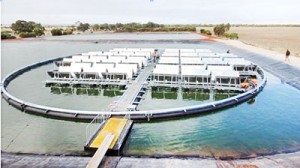Sunday Times 2
Floating solar electric systems
The cost of photovoltaic systems has come down drastically during the last few years, thanks to rapid advances in mass production technology and the increase in demand. The interest in installation of very large systems has met with a new constraint, shortage of land.

A floating solar electric system: An alternative to land-based plants
Floating solar electric power plants is an innovative concept that provides an alternative to land based plants. Irrigation reservoirs, channels, and waste water ponds are water surfaces that have attracted floating solar systems in countries ranging from India to the United States. Most recently Australia installed the first stage of a 3.2 MW system covering 3.4 ha of water surfaces designed to generate 13.7 MWh per day. Many more large systems are planned around the world.
Sri Lanka located in the tropics receives abundant sunshine averaging about 5 kWh per sqm per day. The conversion efficiency of current photo electric devices is about 15 percent and the electrical energy generation potential from solar radiation is about 200 kWh per sqm per year.
The total electrical energy generation in Sri Lanka is projected as 15,000 GWh in 2018. Harvesting solar energy about 75 square km area is required to meet the total electrical energy needs of the country by 2018. The total land area of Sri Lanka is about 65,000 sq km. Although 75 sq km is a small fraction of the total land area, dedicating this much area for a single purpose is a difficult proposition even if all other factors are favorable.
Dry zone of Sri Lanka is scattered with irrigation tanks with large surface areas like,
Senanyaka Samudraya 76.8 sq km; Maduru Oya 62.8 sq km; Uda Walawe 34.8 sq km; Parakrama Samudraya 21.4 sq km; and Minneriya 18.7 sq km. These reservoirs and many others can provide large surface areas to harness a substantial portion of the national electrical energy requirement.
Floating solar electric systems have several other major advantages besides saving valuable land area. Floating solar systems reduce solar energy falling on the water surface and reduce the evaporation from the water surface. The water saved over one hectare is reported as about 18,000 cubic meters per year. This is an astonishing 70 percent reduction in evaporation. This saved water can cultivate 0.7 ha of paddy of two seasons. Reduced solar radiation reaching water body reduces algae growth which is a problem in many reservoirs.
The solar electric cells operate at higher efficiency at lower temperatures. Typically, reduction in i° C in operating temperature increases efficiency by about 0.5%. Solar cells floating over vast water surfaces are cooler and operate more efficiently than land based cells and generate about 5% more electricity from the same incident radiation. Much higher improvements in efficiency are reported. Floating systems will be less prone to dust contamination and cleaning would be easier with readily available water supply.
Solar energy plants at distant locations need to be connected to the national grid for transmission. High tension lines and substations are costly components of the overall system. Some dry zone reservoirs, like Senanayake Samudraya and Uda Walawe already have national grid connections as part of the hydroelectric system infrastructure. It should be possible for the solar plants to share the same infrastructure. Additional hydroelectric systems may become economically feasible in more dry zone reservoirs in combination with floating solar plants.
Solar radiation is available only during the daytime but the high demand for electricity is during the night. This situation can be addressed by pumped storage hydro systems that can be incorporated when solar power systems are integrated with hydroelectric reservoirs. This technology is well developed in advanced countries and round-trip efficiencies over 70% are reported for newer pumped storage hydro systems.
Floating solar electric systems in scenic reservoirs could also include recreational facilities like boating, fishing, and picnic areas which could generate additional revenue.
This write-up was submitted to Public Utilities Commission in September 2015 for inclusion in the long-term generation plan.
(The author is an engineer residing on Kandy. He can be contacted at jatalm@live.com)

